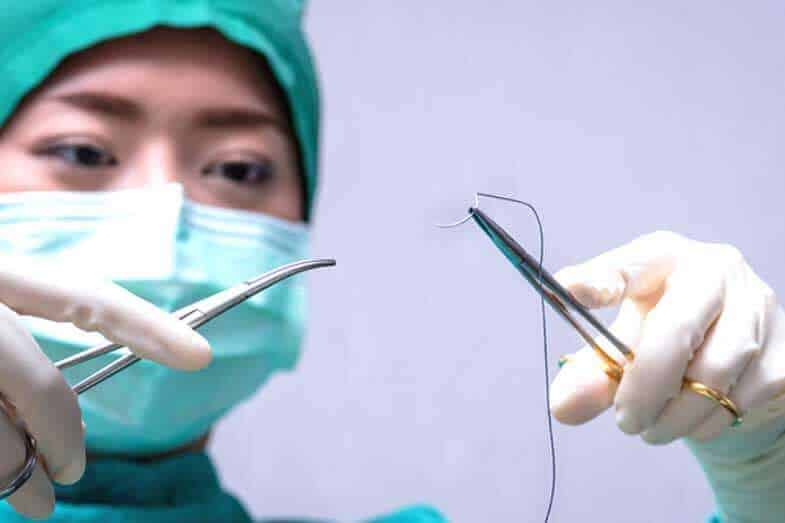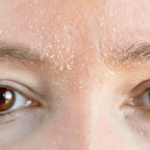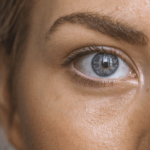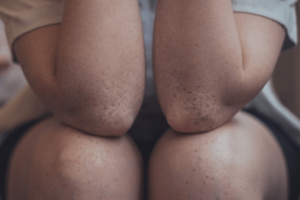Stitches on the face, like any part of your body, need to be left in for a good amount of time until a wound is fully healed. But you don’t want to leave them in too long as that would leave a permanent scar. How long should stitches stay in face?
The length of time that stitches should stay in your face is usually from 5 to 7 days. This is for moderate wounds that are not too deep or too serious. The factors that affect how long the stitches should stay in include the depth and length of the wound, also the type of stitches used.
Your doctor should advise you of the right amount of time to leave them in for. Read on to learn more about how long stitches should stay in your face and the risks of removing them at the wrong time.
How Long Should Stitches Stay in Face?
Stitches should stay in your face for 5 to 7 days. Removing them earlier could spread the scar, cause tissue reaction, and increase the risk of infection. On the other hand, removing them after more than 7 days could create ugly stitch scars as well.
Additionally, there are stitches that are dissolvable or absorbable, which are used for deeper wounds. These need not be removed because they dissolve in the tissue over time. Only the non-dissolvable stitches on the skin need to be removed.
Using dissolvable stitches on the surface of the skin requires a certain skill and expertise from the doctor, as they will have to close the wound just beneath the epidermis and still should make sure that the opening in the skin is closed completely.
So it’s up to the doctor whether they would use absorbable stitches on both deep wounds and skin lacerations. If they did use dissolvable stitches, it takes about 10 days for them to dissolve fully. Non-dissolvable stitches take about 5 to 7 days until you can remove them.
Factors Affecting How Long Stitches Stay in Face
1. Depth of the Wound
When the wound has penetrated deeper tissues, the doctor has to use dissolvable or absorbable stitches so he doesn’t need to remove them later on. There’s no way he can remove them anyway, as they are buried underneath the skin.
So, in this particular case, the stitches found in the deeper tissues of the face are not removed. The stitches can be dissolved completely – usually after 3 months. Only the non-dissolvable stitches would be removed after 5 to 7 days.
2. Length of the Wound
The length of the wound can affect the removal of the stitches. If the wound is longer – the more stitches it would naturally receive. The longer the wound is, the risk of exposure to infective agents or microbes.
To decrease the risk of exposing the wound to infections, the stitches could be removed alternately within a period of 5 to 7 days. Stitches that are for longer wounds may need to be in place for a longer period to ensure the wound is fully healed and no infection can occur.
3. Type of Stitches Used
There are thick and thin stitches, which are used according to the type of wound. Doctors used the thicker stitches for tougher tissues, while the thinner ones are used for more sensitive tissues.
For facial tissues, typically, they stitch the wound using the thinner stitches, as facial skin is thinner than other parts of the body. Some of the lower parts of the body have thicker skin; thus, the stitches stay in place for a longer period of time. For wounds in the chest, the stitches stay longer, from 10 to 14 days.
Another example is when the stitches are found in the knee. Since the knee is flexed more often, the stitches have to stay in place for a longer period of time, so the knee wound could heal completely.
4. Tension Across the Wound
The tension depends on the thickness of the stitch. Thinner stitches have less tension, while thicker stitches have more tension. Hence, they are stitched closer together. With these types of stitches, the doctor may choose to remove some of the stitches (alternate stitches) after 5 days and then remove the rest after 7 days.
It varies, and your doctor would be the best judge to know what applies to your specific case. Generally, the greater the tension, the longer the stitches should stay in place.
That’s why the stitches in the lower extremities take 14 to 21 days before they can be removed, as the tension is greater in those areas. This is because you move and stretch your legs more often.
See the below video to learn more about how stitches work, including how long they should be in for:
How to Care for the Wound While the Stitches Are in Place
To ensure your face wound heals quickly, you should give proper care for it while the stitches are in. The doctor may request you to go back every other day for the cleaning of your wound, or they may give you instructions on how to clean your wound at home. Here are some tips on how to care for the wound at home:
- Don’t wet the wound at least 48 hours after operation. This is for small wounds. For bigger wounds, you will have to follow your doctor’s advice.
- Dress the wound every other day with clean water and sterile gauze or bandaid. Take care not to soak it. Too much water will prevent the drying and healing of the tissue. Some doctors would allow you to dress the wound twice a day, but this would depend on the type of wound in your face. To play safe, ask instructions from your doctor or health care specialist.
- Don’t attempt to remove the stitches yourself, because you may cause injury or you could infect the wound. The wound should always be treated in an aseptic manner. Microbes are everywhere, and they can easily enter your open wound if you don’t use clean and sterile materials.
What to Expect During the Removal of the Stitches in Your Face

You should be instructed by your doctor to come in to have the stitches removed from your face after 5 to 7 days. Always go based on what your doctor advises, however, as this length of time can vary.
The removal of the stitches in your face is painless with the services of a skilled doctor. You will feel a slight tug when the stitch is pulled out from your skin, but it’s not painful, as the wound would have been healed by then.
The doctor or health care personnel will apply antiseptic and a bandage or sterilized gauze, depending on the size of the wound. Also, they may leave it without cover if the skin is completely sealed and healed.
Does Bleeding Occur in Face When Stitches Are Removed?
No, there should be no bleeding when the stitches on your face are removed. Bleeding could indicate that the surgery didn’t go well. This is because the bleeding can be caused by a tissue that is not completely healed and stitched properly into place.
The bleeding can also be caused by an open wound, an infection, or irritation. You should consult your doctor immediately before it gets worst. You wouldn’t want to be stitched up again, right?
What to Do When Complications Occur after Removal of the Stitches
When the doctor schedules you to go back for the removal of your stitches, you should go. They have to remove the stitches at the proper time to prevent infection or scarring. Thus, the length that the stitches stay in your face would depend on your doctor’s advice too.
After the stitches are removed, if you notice pus formation, foul odor, fever, pain, inflammation, redness, or opening of the wound, you have to go back to your doctor for immediate treatment. The wound should not reopen as this can cause infection from external agents, such as bacteria or fungi.
The doctor may have to stitch it again if the open wound is wide and serious. For minor inflammations and other symptoms, they may prescribe a skin cream or an oral medication.
Conclusion – How Long Should Stitches Stay in Face?
So, how long should stitches stay in face? The stitches should stay in your face for 5 to 7 days. Removing them earlier or longer than that can cause complications, such as infections from open wounds and ugly scarring.
Furthermore, while the stitches are in your face, you have to attend to them as directed by your doctor. Follow their at-home instructions properly to prevent infection and re-opening of the wound.
There are exceptions when the stitches in the face are not removed, as when the stitches are dissolvable or absorbable. This happens when deep facial tissues are injured.
Follow your doctor’s advice for when to go back to get them removed, and you will have a seamless and easy experience.

![Say Goodbye To Wrinkles On The Face [Easy Tips to Prevent Them] wrinkles on face](https://skincaregeeks.com/wp-content/uploads/2023/04/wrinkles-on-face-1-2-150x150.png)






